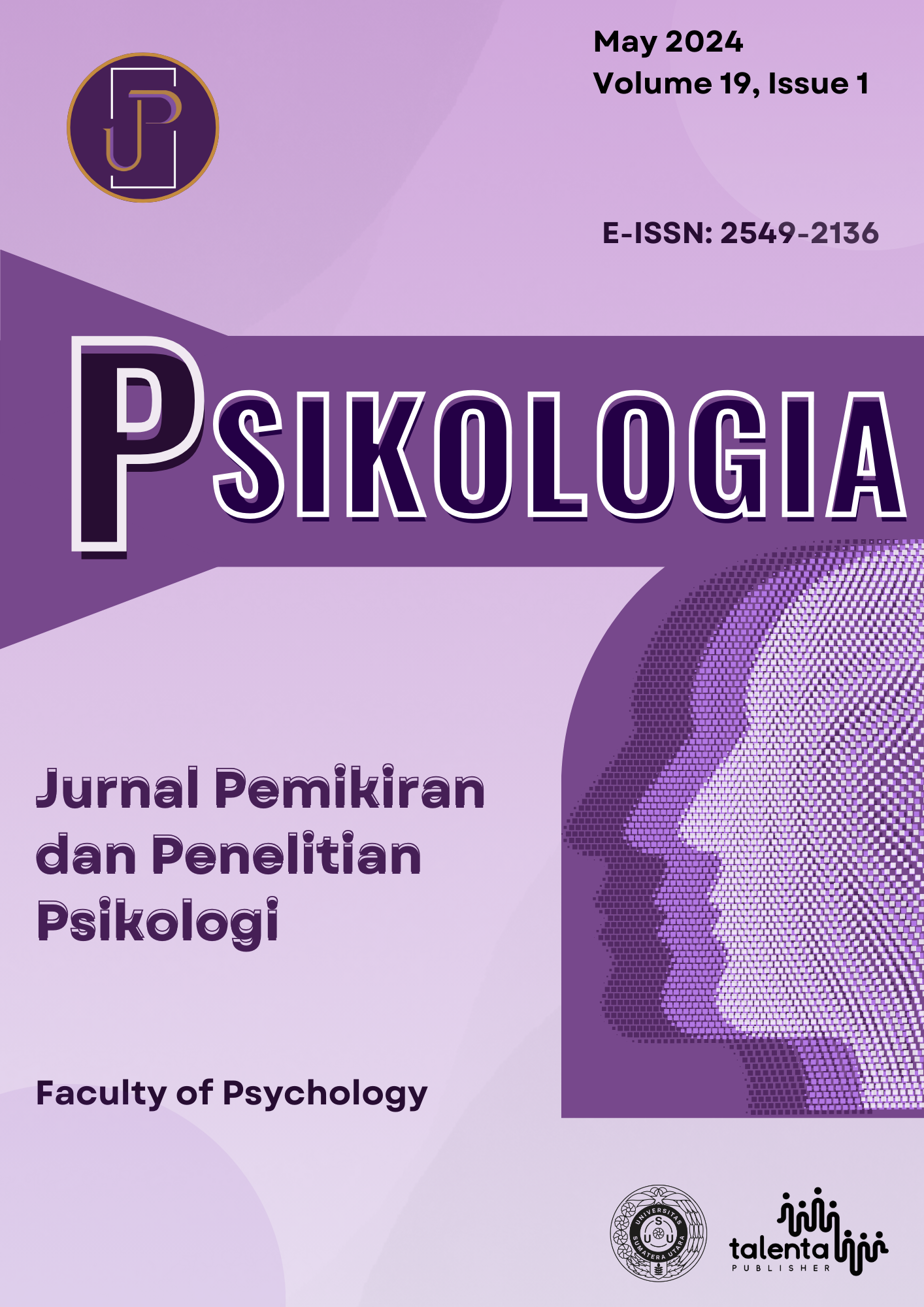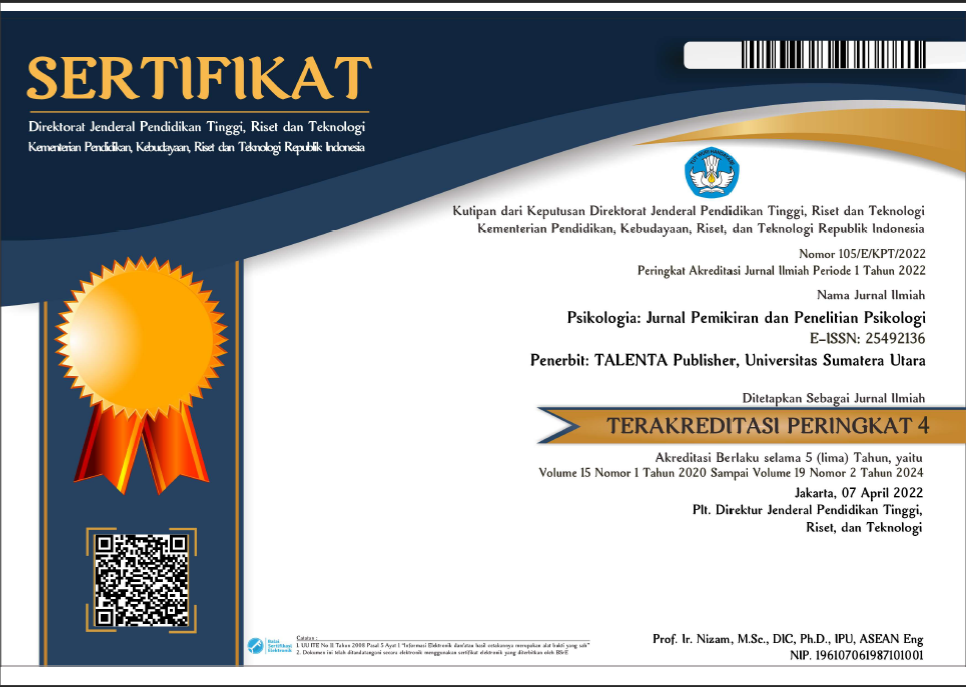The impact of loneliness and anonymity on self-disclosure among social media X users
DOI:
https://doi.org/10.32734/psikologia.v19i1.15271Keywords:
self-disclosure, loneliness, anonymityAbstract
The rapid development of social media enables individuals to self-disclose on communication sites within social media. This study examines the influence of loneliness and anonymity on self-disclosure among users X (Twitter). The subjects of this research are X users with anonymous accounts ranging from 17 to 40 years old, totaling 356 participants. Employing a quantitative approach, the researcher adopted the Revised Self-Disclosure Scale (RSDS) to measure the self-disclosure variable, the UCLA Loneliness version 3 to measure loneliness, and the Lee, Choi, and Kim anonymity scale to measure anonymity. The research results indicate that both loneliness and anonymity, both partially and simultaneously, impact the self-disclosure of social media X users.
Downloads
References
Akbar, S. K., & Abdullah, E. S. P. S. (2021). Hubungan antara kesepian (loneliness) dengan self disclosure pada mahasiswa Universitas Teknologi Sumbawa yang menggunakan sosial media (Instagram). Jurnal TAMBORA, 5(3), 40–45. https://doi.org/10.36761/jt.v5i3.1313
Annur, C. M. (2023). Pengguna Twitter di Indonesia capai 24 juta hingga awal 2023, peringkat berapa di dunia? Databoks. https://databoks.katadata.co.id/datapublish/2023/02/27/pengguna-twitter-di-indonesia-capai-24-juta-hingga-awal-2023-peringkat-berapa-di-dunia
Arikunto, S. (2002). Metodologi penelitian suatu pendekatan proposal. PT. Rineka Cipta.
Arnus, S. H. (2020). Self disclosure di media sosial pada mahasiswa IAIN Kendari. Fakultas Ushuluddin, Adab, Dan Dakwah IAIN Kendari, 11(2), 1–18.
Azwar, S. (2013). Metode penelitian. Pustaka Belajar.
Baron, R. A., & Byrne, D. E. (1997). Social psychology. Prentice Hall.
Bazarova, N. N., & Choi, Y. H. (2014). Self-disclosure in social media: Extending the functional approach to disclosure motivations and characteristics on social network sites. Journal of Communication, 64(4), 635–657. https://doi.org/10.1111/jcom.12106
Cahyani, I. P., & Syaikhah, H. (2023). Studi fenomenologi : Proses self-disclosure akun pseudonim di twitter (Phenomenological study : Self-disclosure process of pseudonymous accounts on Twitter). 06(02), 137–153.
Chairunnisa. (2018). Pengaruh kesadaran diri dan anonimitas terhadap keterbukaan diri pengguna media sosial. Universitas Islam Negeri Syarif Hidayatullah.
Deters, F. große, & Mehl, M. R. (2013). Does posting Facebook status updates increase or decrease loneliness? An online social networking experiment. Social Psychological and Personality Science, 4(5), 579–586. https://doi.org/10.1177/1948550612469233
Ernst, M., Niederer, D., Werner, A. M., Czaja, S. J., Mikton, C., Ong, A. D., Rosen, T., Brähler, E., & Beutel, M. E. (2022). Loneliness before and during the COVID-19 pandemic: A systematic review with meta-analysis. American Psychologist, 77(5), 660–677. https://doi.org/10.1037/amp0001005
Festinger, L. (1957). A theory of cognitive dissonance. IL: Row, Peterson.
Firdia, A. (2023). Emang boleh remaja se-stres itu? Kompasiana. https://www.kompasiana.com/safirra/6533307e110fce32f3793022/emang-boleh-remaja-se-stres-itu
Grady, J. S., Her, M., Moreno, G., Perez, C., & Yelinek, J. (2019). Emotions in storybooks: A comparison of storybooks that represent ethnic and racial groups in the United States. Psychology of Popular Media Culture, 8, 207–217. https://doi.org/10.1037/ppm000018
Harianto, K. E. (2018). Hubungan antara kesepian dan intensitas penggunaan media sosial pada dewasa awal. Universitas Brawijaya.
Hu, C., Kumar, S., Huang, J., & Ratnavelu, K. (2017). Disinhibition of negative true self for identity reconstructions in cyberspace: Advancing self discrepancy theory for virtual setting. PLoS ONE, 12(4), 1–19. https://doi.org/10.1371/journal.pone.0175623
Hurlock, E. B. (2009). Psikologi perkembangan: Suatu perkembangan sepanjang rentang kehidupan. Erlangga.
Iskandar. (2023). Banyak mahasiswa bunuh diri, peneliti: Ini penyebabnya. Jawa Pos: Radarsemarang.Id. https://radarsemarang.jawapos.com/edukasi/723070576/banyak-mahasiswa-bunuh-diri-peneliti-ini-penyebabnya?page=2
Kang, R., Brown, S., & Kiesler, S. (2013). Why do people seek anonymity on the internet? Informing policy and design. Conference on Human Factors in Computing Systems - Proceedings, 2657–2666. https://doi.org/10.1145/2470654.2481368
Kaveladze, B. (2021). Komunitas online memang berisiko bagi kaum muda, tapi mereka juga merupakan sumber dukungan yang penting. The Conversation. https://theconversation.com/komunitas-online-memang-berisiko-bagi-kaum-muda-tapi-mereka-juga-merupakan-sumber-dukungan-yang-penting-168290
Lee, H., Choi, J., & Kim, K. K. (2013). Impact of anonymity (unlinkability, pseudonymity, unobservability) on information sharing. Proceedings - Pacific Asia Conference on Information Systems, PACIS 2013.
Levi-Belz, Y. (2016). To share or not to share? The contribution of self-disclosure to stress-related growth among suicide survivors. Death Studies, 40(7), 405–413. https://doi.org/10.1080/07481187.2016.1160164
Luo, M., & Hancock, J. T. (2020). Self-disclosure and social media: Motivations, mechanisms and psychological well-being. Current Opinion in Psychology, 31, 110–115. https://doi.org/10.1016/j.copsyc.2019.08.019
Ma, X., Hancock, J., & Naaman, M. (2016). Anonymity, intimacy, and self-disclosure in social media. Conference on Human Factors in Computing Systems - Proceedings, 3857–3869. https://doi.org/10.1145/2858036.2858414
Mailanda, D. (2022). Hubungan antara kecemasan sosial dan kesepian dengan self-disclosure pada remaja pengguna Instagram [Universitas Islam Negeri Sultan Syarif Kasim Riau]. http://repository.uin-suska.ac.id/id/eprint/64501
Maradoni, & Rozali, Y. A. (2022). Komunikasi Interpersonal sebagai Pembentuk Intimacy pada Dewasa Awal yang Berpacaran. JCA Psikologi, 3(1), 73–81. https://jca.esaunggul.ac.id/index.php/jpsy/article/view/190%0Ahttps://jca.esaunggul.ac.id/index.php/jpsy/article/download/190/189
Maulidina, A. Z. (2023). Anonimitas media sosial sebagai penyaring kedekatan dan pengungkapan diri. Universitas Sebelas Maret.
Muhamad, N. (2023). Ada 971 kasus bunuh diri sampai Oktober 2023, terbanyak di Jawa Tengah. Databoks. https://databoks.katadata.co.id/datapublish/2023/10/18/ada-971-kasus-bunuh-diri-sampai-oktober-2023-terbanyak-di-jawa-tengah#:~:text=Berdasarkan data Pusat Informasi Kriminal Nasional %28Pusiknas%29 Kepolisian,diri sepanjang tahun 2022 yang jumlahnya 900
Nguyen, M., Bin, Y. S., & Campbell, A. (2012). Comparing online and offline self-disclosure: A systematic review. Cyberpsychology, Behavior, and Social Networking, 15(2), 103–111. https://doi.org/10.1089/cyber.2011.0277
Noviyanti, S. (2008). Skeptisisme profesional auditor dalam mendeteksi kecurangan. Jurnal Akuntansi Dan Keuangan Indonesia, 5(1), 102–105.
Pertiwi, W. I. B. (2016). Pengaruh kesepian terhadap pengungkapan diri remaja di media sosial. Universitas Negeri Jakarta.
Pramesti, C. S. L., & Dewi, D. K. (2022). Pengaruh anonimitas terhadap self disclosure pada generasi Z di Twitter. Character: Jurnal Penelitian Psikologi, 9(5), 51–64. https://ejournal.unesa.ac.id/index.php/character/article/view/47347
Purnama Sari, W., & Irena, L. (2023). Model self-disclosure generasi Z pengguna berat media sosial. Jurnal Ilmu Komunikasi, 12(1), 146–164.
Putra, I. P. G. D., & Marheni, A. (2015). Hubungan kebutuhan afiliasi dengan intensitas penggunaan jejaring sosial Twitter pada remaja akhir. Jurnal Psikologi Udayana, 2(1), 48–58. https://doi.org/10.24843/jpu.2015.v02.i01.p05
Rahardjo, W., Qomariyah, N., Hermita, M., Suhatril, R. J., Marwan, M. A., & Andriani, I. (2020). Online adolescent’s self-disclosure as social media users: The role of extraversion personality, perception of privacy risk, convenience of relationship maintenance, and self-presentation. Jurnal Psikologi, 19(3), 219–232. https://doi.org/10.14710/jp.19.3.219-232
Rahmadina, R. M. (2019). Pengaruh needs, secure attachment, harga diri, dan jenis kelamin terhadap self-disclosure pada remaja pengguna media sosial. Universitas Islam Negeri Syarif Hidayatullah.
Ratih, M. (2021). Curhat anonim di Twitter : Yuk, jadi pendengar yang baik. Kumparan.Com. https://kumparan.com/maulina-ratih/curhat-anonim-di-twitter-yuk-jadi-pendengar-yang-baik-1x4AmtvLhqn/4
Rini, L. N., & Manalu, S. R. (2020). Memahami penggunaan dan motivasi akun anonim Instagram di kalangan remaja. Interaksi Online, Vol. 9, No, 1–14.
Russel, D. W. (1996). UCLA Loneliness Scale (version 3): Reliability, validity, and factor structure. Journal of Personality Assessment, Vol. 66(1).
Safuan, A. (2023). Fenomena remaja bunuh diri di Semarang diduga masalah komunikasi. Media Indonesia. https://m.mediaindonesia.com/nusantara/620531/fenomena-remaja-bunuh-diri-di-semarang-diduga-masalah-komunikasi
Santrock, J. W. (2012). Life-span development: Perkembangan masa hidup (B. Widyasinta (ed.); 13 Jilid 1). Erlangga.
Saputra, D. B. (2023). Hubungan antara anonimitas dengan keterbukaan diri pengguna media sosial pada mahasiswa Fakultas Psikologi UNINSULA. Universitas Islam Sultan Agung.
Sari, T. T. (2020). Self-efficacy dan dukungan keluarga dalam keberhasilan belajar dari rumah di masa pandemi COVID-19. Education Journal : Journal Educational Research and Development, 4(2), 127–136. https://doi.org/10.31537/ej.v4i2.346
Sugiyono. (2013). Metode penelitian kuantitatif, kualitatif, dan r & d. In Alfabeta.
Valkenburg, P. M., & Peter, J. (2009). Social consequences of the Internet for adolescents: A decade of research. Current Directions in Psychological Science, 18(1), 1–5. https://doi.org/10.1111/j.1467-8721.2009.01595.x
Wheeless, L. R., & Grotz, J. (1976). Conceptualization and measurement of reported selfâ€disclosure. Human Communication Research, 2(4), 338–346. https://doi.org/10.1111/j.1468-2958.1976.tb00494.x
WHO. (2023). Suicide. World Health Organization. https://www.who.int/news-room/fact-sheets/detail/suicide
Widiyanti, F. A. (2021). Self disclosure: Sebuah dilematis pengungkapan diri. MediaPublica.Co. https://mediapublica.co/2021/05/30/self-disclosure-sebuah-dilematis-pengungkapan-diri/#:~:text=Pengungkapan diri dengan menggunakan media sosial sangat umum,pengaruh buruk seperti komentar jahat hingga pelecehan verbal
Zahrabella, S., & Herdajani, F. (2023). Hubungan harga diri dan kesepian dengan keterbukaan diri pada content creator Tiktok di Jakarta Barat. Jurnal Psikologi Kreatif Inovatif, 3(1), 144–152. https://journals.upi-yai.ac.id/index.php/PsikologiKreatifInovatif/issue/archive
Downloads
Published
How to Cite
Issue
Section
License
Copyright (c) 2024 Maindah NurLaili Asari, Tatik Mukhoyyaroh

This work is licensed under a Creative Commons Attribution-ShareAlike 4.0 International License.









